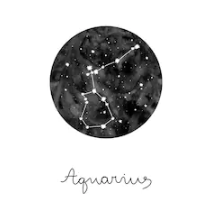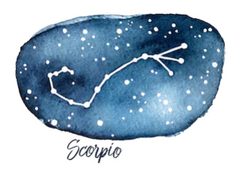Let's take a closer look at some of the constellations that could be appearing in your star map jewelry piece from StarMapJewelry.
The International Astronomical Union recognizes 88 constellations covering the entire northern and southern sky. Here is a selection of the most familiar and easily seen constellations in the northern sky.
Constellations


Aquarius, the water bearer, is one of the most famous constellations. The constellation's two brightest stars, Sadalmelik and Sadalsuud, inancient Arabic mean “lucky one of the king” and“luckiest of the lucky.” The names may refer to the stars' positions.


Look for Aquila high in the south in late summer, it glides on outstretched wings. It glows in the band of the Milk Way. Altar “the eagle,” is its brightest star and is a white star that is 17 light-years from Earth.

Aries, the ram, is only marked by two fairly bright stars: Hamal is its brightest and Sheratan its second-brightest. Aries is famous because of its location: It is one of the 12 constellations of the zodiac. Known as the ecliptic, these constellations straddle the Sun's path across the sky. In the lore of the sky, spring is associated with this constellation.
In the lore of the sky, spring is associated with this constellation.

Auriga, the celestial charioteer, he is drawn with a goat on his left shoulder, as a man holding the reins in his right hand and the star Capella and two baby goats in his left arm. Look for him in the southern evening sky in January and February.

The name Boötes comes from a Sumerian word that means “Man who drove the great cart.” The “Great Cart” was the big dipper. With brilliant yellow-orange Arcturus at the base of the cone, the brightest stars of Boötes form a cone shape.

Cancer plays a relatively small role in both sky and skylore. In mythology, it forms part of the story of Hercules. Cancer is difficult to find in the sky, because it is a small constellation of faint stars.

Canis Major is known as the Great Dog. According to Greek Myth, Canis Major along with Canis Minor was said to be Orion’s hunting dogs. They loyally follow Orion across the southern skies of winter. Because the brightest star is part of it, Canis Major was said to be one of the most important constellations in the ancient times.

Capricornus, is the 40th biggest constellation in the sky. Capricornus, the sea goat, bounds low across the southern sky in late summer and fall. Capricornus got its name from a Greek myth that says the god Pan was transformed into a half-goat, half-fish.


Named after the vain queen in Greek mythology, Cassiopeia is a constellation in the northern sky. One of the 48 constellations listed by the 2nd-century Greek astronomer, Ptolemy.

The brightest stars of Cygnus form a cross, so is also known as the Northern Cross. It derived its name from the Latinized Greek word for swan. Find it soaring high overhead during late summer evenings.

Gemini
is easy to find as it glides high overhead in mid-winter, above and to the left of Orion. Its name is Latin for “twins.” Gemini is associated with the twins Castor and Pollux in Greek mythology.

The zodiacal constellation Leo, the lion, is one of the largest constellation in the sky. Leo is associated with the Nemean lion in Greek mythology.

Libra represents a balance scale. Its name is Latin for weighing scales. This represented the equinox when night and day were perfectly balanced.

Lyra, the harp, is a small constellation. Lyra is associated with the Greek myth Orpheus, a Greek musician and poet. Lyra contains Vega. Vega is the fifth brightest star and second brightest in northern hemisphere.

Orion
is located on the celestial equator and visible throughout the world. It is a prominent constellation. In the night sky, it is the most recognizable and conspicuous constellation.
The brightest stars in Orion, blue-white Rigel and red Betelgeuse, are both supergiants.

Pegasus is a large pattern of stars marked by a great square, named after the white winged horse Pegasus of the Greek mythology. High in the sky is where he can be seen, starting near the end of summer continuing through autumn if you are from the Northern Hemisphere.

Perseus, the hero, arcs high overhead in fall and early winter. He is named after the Greek mythological hero Perseus. He is the major hero best known for his clever decapitation of Medusa, the monster who turned all people into stone if they looked at her face.

Pisces is one of the largest constellations in the sky. The two celestial fish represent Venus and Cupid, in Roman mythology, who in order to escape the monster typhoon, transformed themselves into fish.

Sagittarius, the archer, slides low across the southern sky of summer. A half-man, half-horse or a centaur holding a bow and arrow.

Three bright stars form the "head" of Scorpius, the celestial scorpion, while its tail curves away below it in the southern sky of summer. Scorpius is Latin for scorpion. Antares is its brightest star. It is very noticeable in the night sky.

Taurus, the bull, is marked by a V-shaped pattern of stars that outlines the bull's face. In the Northern Hemisphere, Taurus is a large and prominent constellation.Taurus commemorates the god Zeus according to the Greek mythology. He turns himself into a beautiful white bull to win the affections of the Phoenician princess Europa.

Ursa Major, the great bear, is always above the horizon in the northern latitudes. Spring is the best time to see it when its high above the northern horizon. Best known as the the Big Dipper.

Virgo is the second-largest constellation, so big that it takes about four hours for the whole thing to clear the eastern horizon. Its name is Latin for virgin. Lying between Leo to the west and Libra to the east it is the second largest constellation. Its brightest star is Spica.
Now you have learned about several of the most familiar constellations.
We see several of these constellations in our Star Map necklaces. They show the unique alignment of the stars in a place and date chosen by you. See what constellations show up in your special star map!
